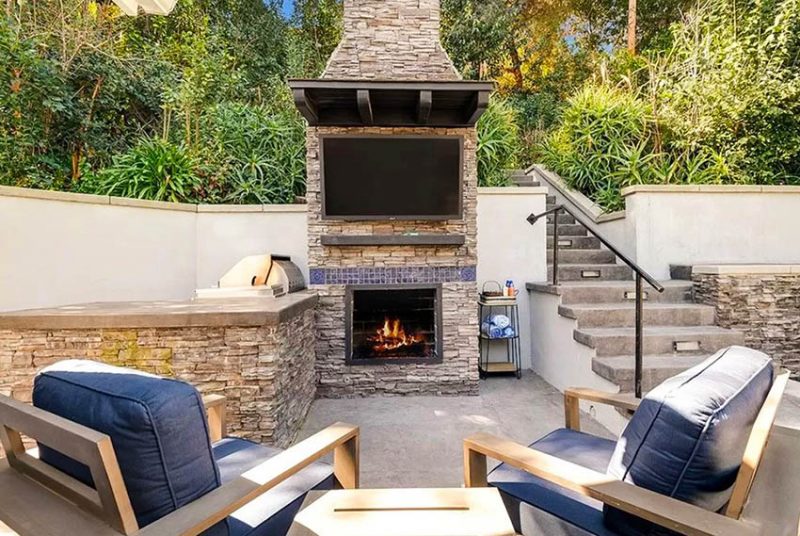Here is our guide to installing an outdoor TV, including the types of TVs you can buy for outdoor use, TV boxes, where you can install and set up your sound system.
Adding an outdoor TV to your garden can be a great way to increase the living space in your home and enjoy it, for you or your family. Watching films under the starry sky can be a fun experience for everyone and brings back beautiful memories. However, before you think about putting your TV outdoors, it is important to know what kind of waterproof outdoor TV you need.
Outdoor waterproof Television
A television that can withstand the elements and the weather is a wise choice for a permanent outdoor installation. These custom-made televisions fight the sun with ultra-bright screens.
What to look for in a waterproof outdoor television:
Before you choose an outdoor TV, you need to know where to put it. This is how different outdoor TVs work best in different locations. B. in full sun, partial sun and shade.
The brightness of televisions is measured in units of light called nits, where a nit is approximately equal to a candle. The more dirt your TV contains, the better it performs in sunlight.
The contrast ratio is the difference between the brightest picture a TV can produce and the darkest picture it can show. To make things even more complicated, there is no standard method for measuring the contrast ratio, and the numbers can be misleading. The best outdoor television is one with a high contrast ratio, because it produces the best picture quality, which is closest to the original. Most televisions today have another dimension of contrast called Dynamic Contrast Ratio. This is a circuit that continuously monitors the video signal and adjusts the brightness as desired. The high dynamic contrast ratio does not compensate for the low natural contrast ratio.
Like sleeping bags, outdoor televisions are also classified according to the temperature they can withstand. If you want to watch TV in a jacuzzi on a snowy winter evening, you should choose a TV suitable for cold temperatures. On the other hand, if you live in an area with a high thermal index, you should look for TVs that can withstand the heat without damaging or damaging the picture.
Make sure that the remote control and any cables or boxes are also weatherproof because they are in the same environment as your TV.
If you are not using a TV, it is best to choose a TV with a guard or cover for entrances and exits. This prevents dust, pollen and insects from penetrating and causing damage.
Outdoor use of an indoor television set
For a big game or a teen sleepover party, it’s tempting to move the indoor TV outdoors. It’s a great solution for the evening, as long as you have enough power, volume and protection against the elements. I’ll say it again: It is best to choose a weatherproof option – a TV set specially designed for outdoor use or a weatherproof TV cabinet.
A private veranda or a covered terrace are two options for the use of the television indoors. However, it is important to ensure that there is no moisture or condensation in the room that could cause problems with the electronics. The main priority when using electronics is safety. Therefore, be sure to use electronic equipment designed for the type of work you need to do.
Television housing for outdoor installation
Modern designed courtyard with two televisions.
It is a good idea to hide electronic devices when they are not in use, to protect them from the elements and the occasional thief. The TV cabinet or enclosure can be sealed and waterproofed, and you can even install a lock for added security.
Choose an attractive wardrobe or let it match your decor. You can also buy vinyl cases that wrap around the TV when it is not in use or have a zipper.
Covered terrace with fireplace and wooden surround for outdoor TV with sound system. See other types of terraces here.
Choosing a location for the outdoor installation of the television
Even a TV designed to withstand the elements cannot be placed everywhere. A television set exposed to direct sunlight is susceptible to thermal damage over time. The television must also be at least one meter away from a heat source such as a propane stove, grill, fireplace or chimney.
A garage, carport, tent, gazebo or pergola are all places where you can watch TV outside if you have a power source. A shady, north-facing location avoids annoying glare. If you have a garden that needs watering, make sure that the television is not exposed to splashes. The same applies if you place it next to a jacuzzi or swimming pool.
If you have an open space with a solid ceiling, the television can be installed there. Restaurant and bar owners can find this tactic very useful as they can install multiple televisions and allow customers to watch the game or the end of the season at one table. Ceiling support is not recommended for prolonged observations due to neck tension.
An existing wall or solid fence is an ideal mounting surface for outdoor television without the need for an additional construction. First install the TV cabinet and then install the TV itself and the soundbar if you are using one.
If none of these options work with your room design, there is another method. You can place a pole (or a terminal) in the ground and attach a TV and/or a piece of furniture to it. This option offers you the greatest investment flexibility.
Wired or wireless for your outdoor TV
The choice of wired or wireless television depends on the equipment you have, the options of your cable or satellite provider and your personal preferences.
The television itself needs a power source. This starts with the output to be interrupted by a ground fault or GFCI. These outlets are easy to find and are often located in kitchens, bathrooms and behind doors – they have a test and reset button.
All wires or cables connecting the TV to the power outlet must be protected against UV rays. Cables are designed for this type of protection, or you can use casings or cable trays designed for outdoor use.
A wired system is more reliable than a wireless system, but a wireless system is generally easier to set up. Some people prefer to set up a wireless network first and then switch to a wired network when reliability is at stake.
Sound system for outdoor television
Mid-range TV loudspeakers are designed to fill a room with sound, using the ceiling and walls as acoustic material. Outside these structures usually don’t exist, so it takes a little creativity to get a good sound.
A soundbar is the best option, so that the game can be heard about the noise of the neighborhood, traffic or children playing in the background. The soundbar can be installed directly under the TV. Choose a TV cabinet with space for a sound bar underneath.
A surround sound system is also an immersion option, but unless your seating space is well defined and semi-permanent, it will be difficult to achieve a balanced sound for all viewers. In addition, the stabilizers must be protected and the cable routing must be continued. The soundbar also allows you to use your outdoor TV as a music source, making it even more versatile and increasing the value of your investment in an outdoor entertainment center.
Visit this gallery page to see other related outdoor televisions.
Related Tags:
watch tv outside wireless,indoor tv outside covered patio,seal tv enclosure,how to mount a tv outside on brick,how to mount a tv outside on stucco,best tv for outdoor use australia,outdoor tv picture settings,best buy outdoor tv,outdoor tv mount,outdoor tv cabinet,abt,outdoor tv installation near me,outdoor hdmi outlet,ip rated tv enclosure,outdoor rated tv,what temperature can a tv withstand?,indoor tv outside reddit,cheap outdoor tv,how long do outdoor tvs last,outdoor lcd tv enclosure,tv settings for outdoor viewing,best outdoor tv,commercial integrator av,commercial integrator 2019,can you leave a tv outside in the cold,outdoor tvs walmart,tv enclosure outdoor,outdoor tvs costco,outdoor tv installation ideas,outdoor tv enclosure,outdoor tv ideas for patio,diy outdoor tv enclosure,outdoor tv cover













